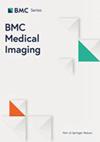Clinical performance of deep learning-enhanced ultrafast whole-body scintigraphy in patients with suspected malignancy
IF 2.9
3区 医学
Q2 RADIOLOGY, NUCLEAR MEDICINE & MEDICAL IMAGING
引用次数: 0
Abstract
To evaluate the clinical performance of two deep learning methods, one utilizing real clinical pairs and the other utilizing simulated datasets, in enhancing image quality for two-dimensional (2D) fast whole-body scintigraphy (WBS). A total of 83 patients with suspected bone metastasis were retrospectively enrolled. All patients underwent single-photon emission computed tomography (SPECT) WBS at speeds of 20 cm/min (1x), 40 cm/min (2x), and 60 cm/min (3x). Two deep learning models were developed to generate high-quality images from real and simulated fast scans, designated 2x-real and 3x-real (images from real fast data) and 2x-simu and 3x-simu (images from simulated fast data), respectively. A 5-point Likert scale was used to evaluate the image quality of each acquisition. Accuracy, sensitivity, specificity, and the area under the curve (AUC) were used to evaluate diagnostic efficacy. Learned perceptual image patch similarity (LPIPS) and the Fréchet inception distance (FID) were used to assess image quality. Additionally, the count-level consistency of WBS was compared between the two models. Subjective assessments revealed that the 1x images had the highest general image quality (Likert score: 4.40 ± 0.45). The 2x-real, 2x-simu and 3x-real, 3x-simu images demonstrated significantly better quality than the 2x and 3x images (Likert scores: 3.46 ± 0.47, 3.79 ± 0.55 vs. 2.92 ± 0.41, P < 0.0001; 2.69 ± 0.40, 2.61 ± 0.41 vs. 1.36 ± 0.51, P < 0.0001), respectively. Notably, the quality of the 2x-real images was inferior to that of the 2x-simu images (Likert scores: 3.46 ± 0.47 vs. 3.79 ± 0.55, P = 0.001). The diagnostic efficacy for the 2x-real and 2x-simu images was indistinguishable from that of the 1x images (accuracy: 81.2%, 80.7% vs. 84.3%; sensitivity: 77.27%, 77.27% vs. 87.18%; specificity: 87.18%, 84.63% vs. 87.18%. All P > 0.05), whereas the diagnostic efficacy for the 3x-real and 3x-simu was better than that for the 3x images (accuracy: 65.1%, 66.35% vs. 59.0%; sensitivity: 63.64%, 63.64% vs. 64.71%; specificity: 66.67%, 69.23% vs. 55.1%. All P < 0.05). Objectively, both the real and simulated models achieved significantly enhanced image quality from the accelerated scans in the 2x and 3x groups (FID: 0.15 ± 0.18, 0.18 ± 0.18 vs. 0.47 ± 0.34; 0.19 ± 0.23, 0.20 ± 0.22 vs. 0.98 ± 0.59. LPIPS: 0.17 ± 0.05, 0.16 ± 0.04 vs. 0.19 ± 0.05; 0.18 ± 0.05, 0.19 ± 0.05 vs. 0.23 ± 0.04. All P < 0.05). The count-level consistency with the 1x images was excellent for all four sets of model-generated images (P < 0.0001). Ultrafast 2x speed (real and simulated) images achieved comparable diagnostic value to that of standardly acquired images, but the simulation algorithm does not necessarily reflect real data.深度学习增强型超快全身闪烁扫描在疑似恶性肿瘤患者中的临床表现
目的评估两种深度学习方法在提高二维(2D)快速全身闪烁扫描(WBS)图像质量方面的临床性能,其中一种方法利用真实临床数据对,另一种方法利用模拟数据集。研究人员回顾性地纳入了83名疑似骨转移患者。所有患者都以20厘米/分钟(1次)、40厘米/分钟(2次)和60厘米/分钟(3次)的速度接受了单光子发射计算机断层扫描(SPECT)全身扫描。我们开发了两种深度学习模型,用于从真实和模拟快速扫描中生成高质量图像,分别称为 2x-real 和 3x-real(从真实快速数据中生成的图像)以及 2x-simu 和 3x-simu(从模拟快速数据中生成的图像)。采用 5 点李克特量表评估每次采集的图像质量。准确性、灵敏度、特异性和曲线下面积(AUC)用于评估诊断效果。学习感知图像斑块相似度(LPIPS)和弗雷谢特起始距离(FID)用于评估图像质量。此外,还比较了两种模型在 WBS 计数水平上的一致性。主观评估结果显示,1x 图像的总体图像质量最高(Likert 分数:4.40 ± 0.45)。2x-real、2x-simu 和 3x-real、3x-simu 图像的质量明显优于 2x 和 3x 图像(Likert 评分:3.46 ± 0.47、3.79 ± 0.55 vs. 2.92 ± 0.41,P 0.05),而 3x 真实图像和 3x 模拟图像的诊断效果优于 3x 图像(准确率:65.1%、66.35% vs. 59.0%;灵敏度:63.64%、63.64% vs. 64.71%;特异性:66.67%、69.23% vs. 55.1%。所有数据均小于 0.05)。客观地说,真实模型和模拟模型在 2x 和 3x 组的加速扫描中都显著提高了图像质量(FID:0.15 ± 0.18、0.18 ± 0.18 vs. 0.47 ± 0.34;0.19 ± 0.23、0.20 ± 0.22 vs. 0.98 ± 0.59。LPIPS:0.17 ± 0.05、0.16 ± 0.04 vs. 0.19 ± 0.05;0.18 ± 0.05、0.19 ± 0.05 vs. 0.23 ± 0.04。所有 P < 0.05)。在所有四组模型生成的图像中,计数水平与 1x 图像的一致性都非常好(P < 0.0001)。超快 2 倍速(真实和模拟)图像的诊断价值与标准采集图像相当,但模拟算法并不一定反映真实数据。
本文章由计算机程序翻译,如有差异,请以英文原文为准。
求助全文
约1分钟内获得全文
求助全文
来源期刊

BMC Medical Imaging
RADIOLOGY, NUCLEAR MEDICINE & MEDICAL IMAGING-
CiteScore
4.60
自引率
3.70%
发文量
198
审稿时长
27 weeks
期刊介绍:
BMC Medical Imaging is an open access journal publishing original peer-reviewed research articles in the development, evaluation, and use of imaging techniques and image processing tools to diagnose and manage disease.
 求助内容:
求助内容: 应助结果提醒方式:
应助结果提醒方式:


